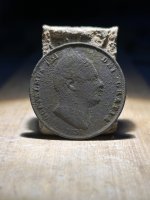treasurejones
Jr. Member
- Oct 4, 2007
- 27
- 0
- Detector(s) used
- Excalibur 2 and a Bounty Hunter Time Ranger
Roman Coins from the Falls of the Ohio
Rev. 6/12/04
Claudius II (left), Maximinus I (right)
Scan courtesy Troy McCormick, of Natural Concepts
In 1963, a construction engineer found a small hoard of coins while excavating the north bank of the Ohio River during construction of the Sherman Minton Bridge for Interstate Highway 64 at the Falls of the Ohio, from New Albany, Ind., to Louisville, Ky. The coins were grouped as though they had originally been in a leather pouch that had long since disintegrated.
The discover kept most of the hoard for himself, but gave two of the coins to another engineer on the project. In 1997, the second engineer's widow brought these two to Troy McCormick, then manager of the new Falls of the Ohio Museum in Clarksville, Ind., not far from the find site. She donated them to the museum, where they remain today.
McCormick identified the smaller coin from a guide to Roman coins as a bronze of Claudius II, from 268 A.D. The larger coin has been identified by both Mark Lehman, president of Ancient Coins for Education, Inc., and Rev. Stephen A. Knapp, Senior Pastor at St. John Lutheran Church, Forest Park, IL, and a specialist in late Roman bronze coinage, as a follis of Maximinus II, from 312 or 313 A.D., despite McCormick's original identification of the coin as a 235 A.D. bronze of Maximinus I.
The coin of Claudius II is similar in type and period to the recently discovered Roman coins from Breathitt Co., Ky., but is in a much better state of preservation. The later coin makes this find several decades later than the Severian Period (193 - 235 A.D.) to which the Roman Head from Calixtlahuaca, Mexico has been attributed on stylistic grounds.
Unfortunately, the discoverer moved south to work on another bridge shortly after the find, and the second engineer's widow could not remember his name, so the bulk of the hoard is lost.
For several years, the Falls of the Ohio Museum had an exhibit about the find that displayed several casts of both sides of the two originals, so as to reflect the approximate number of coins originally in the hoard. The two original coins, depicted above, are in storage and were not on public display. McCormick has informed me that the exhibit has recently been removed from public display, because the Museum belongs to the state of Indiana, and the exhibit conflicted with the state's archaeological policy that there is no documented evidence of pre-Columbian contacts.
The hoard is not included in Epstein's 1980 survey of coin finds in the U.S.
McCormick is currently President and owner of Natural Concepts, a museum and exhibit consulting firm. The author is grateful to him for providing this information and the above images.
Rev. 6/12/04
Claudius II (left), Maximinus I (right)
Scan courtesy Troy McCormick, of Natural Concepts
In 1963, a construction engineer found a small hoard of coins while excavating the north bank of the Ohio River during construction of the Sherman Minton Bridge for Interstate Highway 64 at the Falls of the Ohio, from New Albany, Ind., to Louisville, Ky. The coins were grouped as though they had originally been in a leather pouch that had long since disintegrated.
The discover kept most of the hoard for himself, but gave two of the coins to another engineer on the project. In 1997, the second engineer's widow brought these two to Troy McCormick, then manager of the new Falls of the Ohio Museum in Clarksville, Ind., not far from the find site. She donated them to the museum, where they remain today.
McCormick identified the smaller coin from a guide to Roman coins as a bronze of Claudius II, from 268 A.D. The larger coin has been identified by both Mark Lehman, president of Ancient Coins for Education, Inc., and Rev. Stephen A. Knapp, Senior Pastor at St. John Lutheran Church, Forest Park, IL, and a specialist in late Roman bronze coinage, as a follis of Maximinus II, from 312 or 313 A.D., despite McCormick's original identification of the coin as a 235 A.D. bronze of Maximinus I.
The coin of Claudius II is similar in type and period to the recently discovered Roman coins from Breathitt Co., Ky., but is in a much better state of preservation. The later coin makes this find several decades later than the Severian Period (193 - 235 A.D.) to which the Roman Head from Calixtlahuaca, Mexico has been attributed on stylistic grounds.
Unfortunately, the discoverer moved south to work on another bridge shortly after the find, and the second engineer's widow could not remember his name, so the bulk of the hoard is lost.
For several years, the Falls of the Ohio Museum had an exhibit about the find that displayed several casts of both sides of the two originals, so as to reflect the approximate number of coins originally in the hoard. The two original coins, depicted above, are in storage and were not on public display. McCormick has informed me that the exhibit has recently been removed from public display, because the Museum belongs to the state of Indiana, and the exhibit conflicted with the state's archaeological policy that there is no documented evidence of pre-Columbian contacts.
The hoard is not included in Epstein's 1980 survey of coin finds in the U.S.
McCormick is currently President and owner of Natural Concepts, a museum and exhibit consulting firm. The author is grateful to him for providing this information and the above images.




